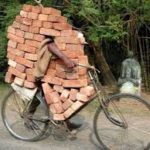 Here is how to work out the overloading of vehicle in absence of load challan-GR-LR & Impact of overloading on insurance claim
Here is how to work out the overloading of vehicle in absence of load challan-GR-LR & Impact of overloading on insurance claim
The carriage of bulk materials is very common and may be one of the easiest ways for a one-man operator to enter the business.
Load challan: Load challan or GR-goods receipt or LR-lorry receipt is an important document while processing a goods carrying commercial vehicle insurance claim. The load carrying capacity of a vehicle depends on size, type & design of the vehicle which is ascertained from laden-unladen wt. mentioned in the registration certificate & route permit of the commercial vehicle.
LR/GR: LR Stands for Lorry Receipt & GR for goods receipt & are also called “Bilti” in Hindi. This receipt is either in 3 copies or 5 copies i.e. Consignee copy, Driver Copy, Consigner Copy and File Copy. This receipt is made by the Transporter once the material is loaded on the vehicle for Delivery.
In case of transportation of goods in organized business sector the GR along with the the invoice for the loaded goods is available for ascertaining the weight of goods being carried out at the time of accident but in case of the unorganized sector, the trucks carrying sand, gravel, stones, clinker, stone chipping, ashes, broken bricks & lot of other building materials etc. which is carried out in loose form & carrier sometimes don’t possess any GR or weigh slip making it difficult for surveyors & insurers to determine the material weight which is required to be in the laden-unladen weight range & permissible load carrying capacity of the vehicle.
This type of material is sold in volumes & carried out in loose form & Wt. estimation of the same becomes little difficult. So if you have any document showing the volume of the material, the wt. can be ascertained with density but in case no document is made available, you have to work out the volume by knowing the length, breadth & height of the open body of the truck & may work out the weight of material with the help of a table below:
Ready reckoner to work out the vol. to wt. of material
One cu. Meter=35.314 cubic ft.
| Material | Weight per cubic meter |
| Dry earth | 1249kg |
| Moist earth | 1442kg |
| DryGravel | 1682Kg |
| Wet gravel | 2002Kg |
| Dry sand | 1602 Kg |
| Wet sand | 1922 |
| Bricks | 1600-1900Kg |
| Broken bricks coarse | 1010Kg |
| Broken bricks fine | 1450Kg |
| Sand stone | 2800Kg |
| Broken stone Grit-dry | 1600-1870Kg |
| Lime stone | 2650Kg |
| Burnt clay | 1600-192oKg |
| Broken dust (sukrhi) | 1010Kg |
| Cement | 1400Kg |
| Collar | 1200 Kg |
| Broken bricks fine | 1450Kg |
| Sand stone | 2800Kg |
| Broken stone Grit-dry | 1600-1870Kg |
| Lime stone | 2650Kg |
| Burnt clay | 1600-192oKg |
| Broken dust (sukrhi) | 1010Kg |
| Cement | 1400Kg |
| Collar | 1200 Kg |
Per cubic meter wt. of liquids
| Petrol | 820Kg |
| Diesal | 830Kg |
| Kerosene | 750Kg |
| Furnace oil | 900Kg |
| Sulphuric acid | 1800Kg |
| Nitric acid | 1500Kg |
| Water | 1600-1900Kg |
| Vegetable oil | 930Kg |
In addition the wt. of one cubic meter wood is about 1200 Kg. If the material is in bags, the wt. can be ascertained easily by weighing one bag. Cement is transported in bags of 50 Kg. each, so twenty bags are equalient of one tonne.
The overloading of the vehicle has direct bearing over vehicle accidents & so insurers can always reject the insurance claim of overloaded vehicle. However some of the insurers ignore 5% of overload & above that 25% deduction is made in the claim amount. But in case of overloading above 25% of the carrying capacity, the claim is rejected out rightly.
Vehicle fitness for insurance claim
J.D.Batta-surveyor & Loss Assessor
Admin-Claim Hub, Chandigarh

